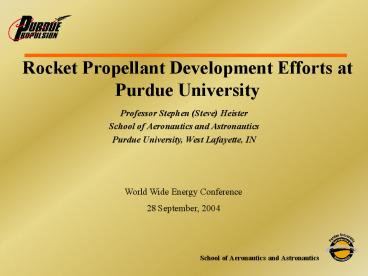Rocket Propellant Development Efforts at Purdue University PowerPoint PPT Presentation
1 / 25
Title: Rocket Propellant Development Efforts at Purdue University
1
Rocket Propellant Development Efforts at Purdue
University
Professor Stephen (Steve) Heister School of
Aeronautics and Astronautics Purdue University,
West Lafayette, IN
World Wide Energy Conference 28 September, 2004
2
Outline
- Overview of Purdue Propulsion Facilities at
Maurice Zucrow Labs - DMAZ Combustion with 90 HP
- Non-toxic Hypergolic Fuels with 98 HP
- -- Vacuum Ignition Testing of Boeing Fuel
- -- Testing of Swift Enterprises Fuel
- AFRL Ionic Liquid Fuel Testing with 98 HP
- Droplet Decomposition Studies
3
Purdue Testing Facilities
- Advanced Propellants Combustion Lab (APCL)
600 sq. ft. of space at Maurice Zucrow Labs
(MZL), includes two reinforced concrete test
cells, associated control room and vacuum
capability - MZL High Pressure Lab
- 6000 sq. ft. of space including two
reinforced concrete test cells, instrumentation
rooms, propellant tankage rooms, and remotely
located control room
4
Maurice J. Zucrow Laboratories
24 Acre remote complex adjacent to Purdue Airport
5
Senior Personnel
- Steve Heister
- Ph.D. UCLA, 1988
- Aerospace Corp. 1983-90, Manager, Propulsion
Technology Section - Lockheed 1981-82, Propulsion Installation
Department - TRW (sabbatical) 1997
- Phillips Lab (AFAL), 1991 Summer Faculty
- Author/co-author of over 100 technical papers in
ballistics, design, atomization, cavitation
Bill Anderson Ph.D. Penn State, 1996 Marshall
Space Flight Center 2000-01, Engineer Orbital
Sciences 1997-2000, Senior Principal Propulsion
Engineer Penn State Propulsion Engineering
Research Center 1990-97, Associate
Director Aerojet 1988-90, Senior Engineer Garrett
Turbine Engine Division 1986-88, Aerothermal
Sciences Engineer Aerojet 1984-86, Thermal
Sciences Engineer
Scott Meyer M.S. Purdue, 1992 Beal Aerospace
Technologies 1998-2001, Propulsion
Engineer Sverdrup Technology (AEDC) 1993-97,
Project Engineer, Propulsion integration wind
tunnel testing US Rocket Works 1990-97,
Co-developed and patented a hybrid rocket motor
ignition device
6
Advanced Propellants and Combustion Lab
- Two cells w/ 1 Klbf thrust stands
- Propellant supply of 1800 psia
- 2 - 4 gallon peroxide tanks (90/98)
- 1 4 gallon fuel tanks
- National Instruments hardware LabView software
- 32 channels pressure
- 32 channels temperature
- All valves computer controlled
- Rapid test article installation
- Design/Build/Test course
7
High Pressure Lab Overview
- Propellant flows
- LOX 15 lb/s
- H2O2 30 lb/s
- LHC 20 lb/s
- H2O 90 lb/s
- 6K psi supply pressure
- Remote control of experiments using LABVIEW
- Unique opportunity for real-scale experiments
- Student involvement is key
- Large NASA investment
- Support and advice from SSC, MSFC, GRC, WSTF
- Research
8
Staged-Bipropellant Dump Combustor
- Modular design to accommodate different fuel
flows and contraction ratios
- Engines built for interface to 90 and 98 HP
catbeds
9
DMAZ Combustion with HP
- Dimethyl-2 Azidoethylamine
- (DMAZ) developed by D. Thompson, AMCOM
- The chemical makeup is (CH3)2NCH2CH2N3
- 90 H2O2 / DMAZ
- 3 sec firing O/F 3.65, 2.1 lb/s
- Pc 430 psia
- C efficiency 99
10
DMAZ Biprop Test Firing
11
Comparison of Autoignition Data
DMAZ fuel ignited under all tested conditions
much more ignitable than JP-8 C effcy 90-100
12
Vacuum Ignition of Hypergolic Fuels
- NASA/MSFC Project Rocketdyne thruster design
- Small exhaust plenum
- attached/sealed with
- thruster nozzle
- Vacuum Release Plate
- - Held in place by vacuum
- - 600-in3 acrylic and metal
- plenum
13
Vacuum Ignition Verified for Rocketdyne
Hypergolic Fuel
- Ignition occurring in vacuum
- Combustor flow chokes before significant rise in
plenum pressure - Video shows combustion exiting thruster, filling
plenum, release plate detaching
14
Vacuum Ignition Tests
15
(No Transcript)
16
Vacuum Ignition Tests
- Comparing vacuum tests with atmospheric tests
- Same presence and magnitude of startup pressure
oscillations - Same startup transient time
- Same steady-state injector and chamber pressures
Hypergolic ignition not affected by vacuum
environment
17
Pintle-Based Bipropellant Combustor
- 200-lbf thrust (vac ideal)
- Stainless steel and copper construction
- Modular design
- Vary engine parameters
- Replace damaged/worn parts
- Over 200 successful firings with several
hypergolic fuels
18
Testing of Swift Enterprises Hypergolic Fuels
- Project funded by NASA MSFC SMDC
- The following solutions were obtained and tested
- Fuel A 4.2 by weight lithium borohydride
- (LBH) in tetrahydrofuran (THF)
- Fuel B 20 lithium aluminum hydride (LAH) in
diethyl ether - LAH Performance was poor due to oxide
- formation in plumbing system and injector
19
THEORETICAL Isp RESULTS
100 HP, Pc 500 psi, Expansion ratio 10
20
LBH/98 HP Firing
21
LBH Test Results
Rapid, reproducible ignition Relatively low
noise (2-3) Fuel flows were low due to check
valve problems
22
AFRL Ionic Fuel Testing
- Fuel under development at AFRL-Edwards AFB in
group of Dr. Tom Hawkins - Fuel tested using 98 HP in staged-biprop dump
combustor - Three test series conducted both steady and
pulsed performance evaluated
23
Droplet Thermal Decomposition Studies
- Inject drops into inert or decomposition products
atmosphere to better approximate combustor
dynamics - Ensemble average diameter measurements at each
discrete location to obtain droplet size history - Measurements at pressures of up to 10 atm
- Investigate behavior of DMAZ, HP, HAN, AFM-315,
ADN, etc.
24
Experimental Apparatus
STROBE LIGHT
DROP GENERATOR
6
CAMERA
TEST CHAMBER
Propellant SYRINGE PUMP
25
Conclusions
- New classes of lower toxicity propellants are
showing promising combustion results - DMAZ combustion/ignition characteristics
- Vacuum ignition verified in nontoxic storables
- Encouraging results obtained for AFRL ionic
liquid fuel and Swift Enterprises LBH-based
hypergol

